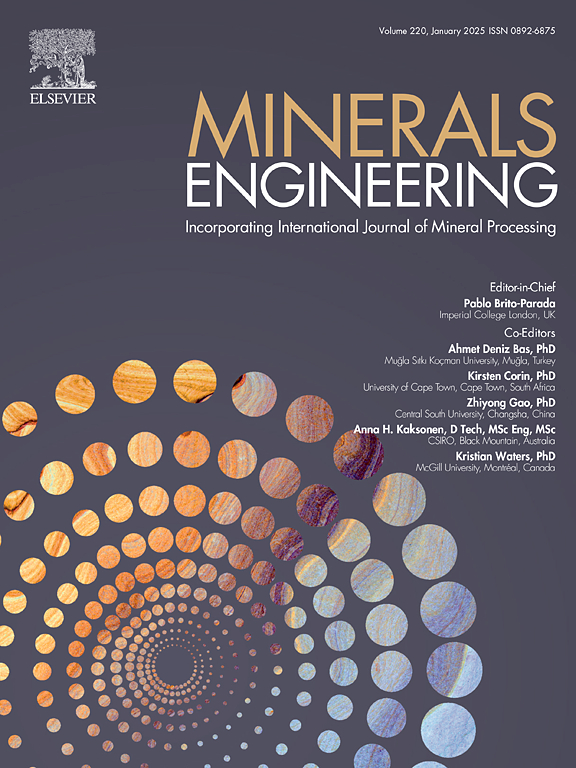Activation flotation and activating mechanism of cyanide-depressed pyrite using sodium persulfate and ferrous sulfate
IF 4.9
2区 工程技术
Q1 ENGINEERING, CHEMICAL
引用次数: 0
Abstract
Cyanide tailings were produced by cyanidation gold extraction and normally contained a large amount of unrecovered valuable metals. At present, there are few pieces of research on the activation flotation recovery of useful minerals in cyanidation tailings. In this paper, the activation flotation of cyanide-depressed pyrite using sodium persulfate (PDS) and ferrous sulfate (Fe(II)) was systematically studied by microflotation tests. The activating mechanism was analyzed by FTIR spectroscopy, zeta potential measurement and electron paramagnetic resonance (EPR) analysis. The microflotation tests showed that pyrite flotation was deeply depressed in the presence of sodium cyanide (NaCN). The flotation of cyanide-depressed pyrite could be largely improved by the addition of individual PDS or combined PDS and Fe(II). The dosage of combined PDS and Fe(II) was lower and their activating effect was better than using PDS alone. Zeta potential measurements and FTIR analysis revealed that NaCN was adsorbed on the pyrite surface to generate the hydrophilic ferricyanide, which can reduce the pyrite floatability. The individual PDS or combined PDS and Fe(II) could react with ferricyanide to destroy the hydrophilic adsorption layer and restore the hydrophobicity of pyrite surface. EPR analysis indicated that the oxidation system of pyrite with combined PDS and Fe(II) could produce more powerful SO4−• and HO• than individual PDS. The radical scavenging experiments further confirmed that the generating free radicals were the active species for the destruction of ferricyanide and reduction of the activator dosage.
求助全文
约1分钟内获得全文
求助全文
来源期刊

Minerals Engineering
工程技术-工程:化工
CiteScore
8.70
自引率
18.80%
发文量
519
审稿时长
81 days
期刊介绍:
The purpose of the journal is to provide for the rapid publication of topical papers featuring the latest developments in the allied fields of mineral processing and extractive metallurgy. Its wide ranging coverage of research and practical (operating) topics includes physical separation methods, such as comminution, flotation concentration and dewatering, chemical methods such as bio-, hydro-, and electro-metallurgy, analytical techniques, process control, simulation and instrumentation, and mineralogical aspects of processing. Environmental issues, particularly those pertaining to sustainable development, will also be strongly covered.
 求助内容:
求助内容: 应助结果提醒方式:
应助结果提醒方式:


